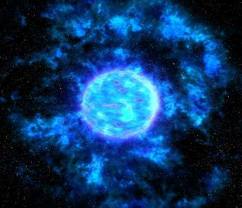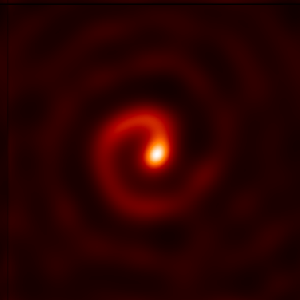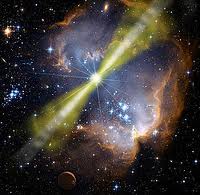
In the past, we’ve covered every cosmological apocalyptic scenario put forth by scientists and conspiracy theorists alike. From the big freeze, to the big crunch, planet x, to strangelets converting all normal matter into strange matter. The likelihood of any of those events happening are very slim. Nevertheless — that does not mean the Earth is not in danger of some cataclysmic event taking place before the sun swells into a red-giant, overtaking the orbits of the innermost planet’s in our solar system. Now, I thought it was only fitting to discuss the possibility of a gamma ray burst bathing our planet in deadly cosmic rays or gamma radiation…especially since most of the other scenarios are not nearly as horrifying as being baked alive, leaving the rest of the planet to die a slow, painful, suffocating death!
The WR 104 system

Located about 8,000 light-years from Earth, in the constellation of Sagittarius, lies a binary star system with two orbiting stars that are both on the verge of exploding as violent supernova blasts. One of the two stars in the WR 104 system is a type 0 star, while the other is a massive, luminous, highly unstable star called a Wolf Rayet star. This is the last known relatively stable phase in the life-spans of similar stars, and most stars like this are regarded as ticking time bombs by astronomers. Together, these two stars are in stable orbits around one another while a plume of gases are driven from the surfaces of the stars, eventually twisting and whirling into a brilliant spiral (as seen in this image). They rotate in a complete circle once every 8 months in orbits that are so precise, one could keep time with them.
Now, back to gamma ray bursts. They are a special flavor of supernova. As the core of a massive stars collapses to form a black hole or a neutron star/pulsar, the outer layers explode outwards, producing two high-powered beams of gamma radiation. These gamma ray bursts are capable of producing more raw energy than our sun will produce in its entire lifespan, all in a few quick moments. While the beams are extremely energetic and damaging to anything that lies in their path, they are also very narrow. The beams would have to be aimed straight toward an object before striking it. Of course, there would be no warning, since the particles travel at nearly the speed of light. Thus, the particles would reach us at almost the same time as the light from the supernova.

The best way to determine where a beam of a gamma radiation is aiming toward is by studying signs in the system of symmetry. In this case, astronomers can study the beautiful rotating spiral of gas that has became entangled from the two stars in the binary system. According to a researcher from the University of Sydney, it’s perfect appearance is only possible if we are looking almost exactly at the axis of the binary system, or 90° from the ecliptic plane. This is problematic since gamma ray bursts appear to be shot straight from the axes or poles of an object, which appears to put us straight in the firing line of the WR 104 system.
The Destruction of Earth:
Assuming the beam of harmful rays did hit Earth, it would be capable of doing irreparable damage to Earth’s atmosphere — maybe even causing a mass extinction event that eradicates humankind entirely. Even a short burst that lasts 10 seconds could deplete over 25% of our ozone later, sending a barrage of ultraviolet rays to the surface of the planet. Even the damage our species has done to the ozone layer over thousands of years would be nothing in comparison to those numbers. The best estimate scientists have gave thus far puts the depletion of the ozone layer between 3 to 4 percent to date.

A nearby gamma ray burst could also trigger smog formation that’s capable of blocking out a percentage of our sunlight, potentially cooling the planet down exponentially. In this scenario, gamma rays would break apart nitrogen molecules in our air and transform them into nitrogen dioxide, which has a reddish-brown hue. Since nitrogen dioxide is water soluble, it would precipitate acid rain on our planet like the Earth’s evil twin, Venus. The side of our planet that was bathed in the radiation would be far more damaged than the side that was facing away at the time when it arrived. It would be the equivalent of that entire portion of the planet being blasted with a nuclear explosion. In fact, evidence has been uncovered that suggests such a beam of radiation might have hit Earth back in the 8th century.
Not so fast!
Another study was done a full year after the initial discovery of the binary system that puts doubts on the accuracy of those numbers above. Spectroscopic emission lines from WR 104’s system indicates that the system may be inclined as much as 30°-40° away from us. Or perhaps it’s off by as much as 45°, which would effectively put us out of harm’s way — so lets not panic! There are many uncertainties about these gamma ray bursts that are not well understood. First, we aren’t sure when the star will go supernova. It could happen any time in the next hundred or thousand years. Nor are we even sure if stars like WR 104 are capable of producing certain gamma ray bursts in the first place. More gamma ray bursts must be observed before the evidence is conclusive!